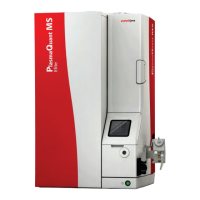PlasmaQuant MS product family Troubleshooting
127
12 Troubleshooting
If the plasma wouldn´t light but there are no error messages indicating a hardware
fault, check the following:
Has anything changed on the instrument since the plasma was last operated?
Faulty connections anywhere in the sample introduction system can introduce air
leaks into the torch, which prevent it from igniting the plasma.
Is the argon supply OK? A contaminated argon tank can contain enough impurities
(usually oxygen and or water) that the plasma cannot light.
If no significant signal is observed for selected isotopes when performing an
instrument setup task, then check the following:
Inspect the sample introduction system and ensure that the test solution is being
pumped into the nebulizer and the solution waste from the spray chamber is
draining properly.
Make sure that a correct system setup solution is prepared and used. The solution
must contain the isotopes that were selected for the instrument setup (see section
"Tuning solution preparations" p. 55).
Ensure that a correct system setup worksheet is selected, and re-tune the method
parameters of the setup worksheet (if necessary) to achieve an adequate sensitivity
for the selected isotope/s, typically over 10,000 c/s per isotope (see section
"Method optimization" p. 75).
If there is still no or very little signal, try a more concentrated version of the tuning
solution (e.g., 100 µg/L instead of 1 µg/L); this may provide enough signal to
enable the fault to be identified and corrected before resuming calibration with the
1 µg/L solution.
It is recommended that the same method (or setup worksheet) should be selected to
perform the plasma alignment, resolution and trim, mass calibration, and detector
setup routines.
Check that the instrument has adequate sensitivity; make sure that a correct system
setup worksheet and solution are used, as described above (see section "Method
optimization" p. 75).
If the instrument sensitivity is too low, re-tune the method parameters of the setup
worksheet (or if necessary prepare a new setup solution), and then repeat the mass
calibration. Otherwise you must perform a peak resolution and trim (see section
"Peak resolution and trim" p. 60).
Do not save the best values found by the calibration, if prompted.
Check the instrument sensitivity and the setup solution. Re-tune the instrument.
Repeat the resolution and trim routine, after re-tuning the method or changing to
a new solution as appropriate.
If the process fails again, then re-set the resolution value (e.g., select 0.75 AMU
instead of 0.8 AMU) and repeat the resolution and trim routine.
Peak Resolution and Trim
Fails

